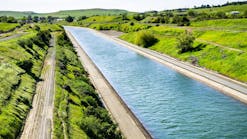About the author:
Corydon Coppola, CPESC, is president of Flo-Water Sediment Controls. Coppola can be reached at [email protected].
Various agencies have discussed the possibility of using turbidity as an effluent standard for construction sites, but turbidity monitoring can be difficult for dynamic construction sites. A project at St. Croix Crossing in Minnesota—south of Stillwater and connecting Oak Park Heights, Minn., and St. Joseph, Wis.—investigated turbidity relationships and developed protocols for the design and installation of cost-effective monitoring systems. At this site, sediment-laden water was releasing into the St. Croix River from barges.
Sediment Control
Regulations and specifications ensure contaminated water is filtered when pumping water. Additionally, the flow rates of established dewatering bags often are limited and blow out as sediment is captured. However, certain advancements enable projects to produce cleaner storm water and eliminate dewatering challenges.
Regulations and construction specifications may require sediment control, erosion prevention, brown water, and pollutant prevention management techniques. Despite well-meaning plans and intentions, coping with turbid water, sediment control or erosion control during active construction can lead to illicit discharges. While gravity discharge failure can occur due to forces beyond our control, dewatering can occur within defined parameters and in control of the contractor. There are many passive and active ways to manage turbid water, but treatment is a function of the soil type, the volume of water to be treated and the total suspended solids.
Research
To investigate ways to manage turbid water, a research study examined the turbidity characteristics of 14 different soils in Minnesota. Trends in turbidity with sediment concentrations were well represented by power functions. The exponent of these power functions was relatively constant between soils, and the log-intercept, or scaling parameter, varied substantially among the different soils. A regression analysis for the scaling parameter was a function of percent silt, integral erodibility, and maximum abstraction. The field studies also were used to develop turbidity monitoring systems that would be adaptable to construction sites and to collect turbidity data on construction site runoff. For example, the construction site turbidities often exceeded 1,000 Nephelometric Turbidity Units (NTU) and sometimes surpassed 3,000 NTU.
Pump-It Tube Dewatering Bags were used in the research to define means and methods for reducing turbidity during construction activities. This was part of a project to actively select a subset of discharge flow and monitor with the intent to ultimately add flocculent chemistries to reduce the sediment load by using automated machines. The tubes were used for real-time automated dewatering of a drill shaft hopper barge dewatering system for final polishing of the discharge prior to release back into a designated wild and scenic river.
The goal was to reach 25 NTU above background—not to exceed 70 NTU for special and impaired waters—and 50 NTU not to exceed 125 NTU for all other waters. The pH was adjusted to be 7.0, +/- 1.0.
The Pump-It dewatering tubes provided benefits for scour control. The small apertures of the heat-bonded non-woven fabric use pressure to force water out of the tube. The tubes also were used along gutter lines for urban utility dewatering work, as part of a treatment train with lined dumpsters and potential chemicals in the pre-treatment flow path. In addition, they worked with a limited footprint for barge surface work areas adjacent to the coffer dewatering. Ultimately, this research helped develop a dewatering guidance document.
This research opens the door for advancements in dewatering bags. The Pump-It tubes enable faster flow rates while capturing more sediment. This is done by using heat-set non-woven geotextile with a built in poly-scrim, which enables multiple layers of the fabric to filter sediment, trash, metals, silica and more by providing a large number of openings layered on top of one another. The built-in polyscrim gives the fabric structural strength, while enabling higher flow rates.
Due to this success, coffer dewatering into treatment dumpsters was discharged into the tubes along work barge edges to the river during bridge pier repairs below the water line. This was a success, and it provided a safe space for barge surface laydown and work area. Originally, contaminated water was stored on the edge of the barge. Now, it can be released.
Ultimately, the problems resolved included reducing the working footprint, reducing downtime, increased flow rates, ease of maintenance, regulatory-approved clean water releasing into the St. Croix River, and increasing sediment capture to an acceptable rate.






